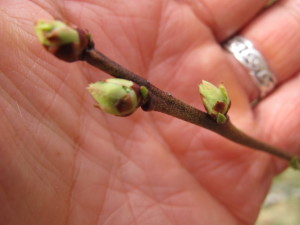Pruning Blueberries
March is a good time to prune not just fruit trees, but also your blueberries. Blueberries here in New England are relatively slow growing, so they don’t need to be pruned every year. But they do need help from time to time.
Ready to prune? Your first question should be,” Has the soil thawed and dried out enough to walk around the bushes without damaging the soil?” This is important. You can damage soil structure and roots by walking on soil that has thawed, but has a layer of frozen soil beneath it. Also if the soil is squishy, making sounds or leaving footprints, you should stay away. Yes, I know you want something to do outside on a warm spring day. But stay away from the blueberries, off the lawn and out of the garden until soil has dried out.
Before making your first cut you need to know the difference between leaf buds and fruit buds. A branch that has few or no fruit buds is a good candidate for your pruners. Snip it off, and it will open up the bush, allowing sunshine to get to the productive branches.
Fruit buds are fat and leaf buds are not, they are slim and pointy. Simple as that. The rounded fruit buds generally produce a cluster of berries, not just a single berry, and you will certainly lose some berries when you take off a branch, it’s inevitable. But let the number of fruit buds on a branch guide you as you make your cuts.
Whether pruning blueberries or apples or pears, you should never cut branches in a way that leaves stubs. Branches heal at their point of origin, either at the trunk or a bigger branch. On larger branches you may notice a larger, almost swollen area called the branch collar; they should remain when pruning any type of branch. If you cut off a branch an inch from the branch collar, the stub will need to rot back to the branch collar before it heals. In the meantime pests or diseases may be attracted to the dying wood.
Pruning is the ultimate game of choices for the gardener. Remove this branch or that? Here are some guidelines for making your choices.
- Removing a few larger branches is generally better than making many small cuts.
- First, remove any dead branches. They don’t count in your calculation of how many branches can be removed – they are not contributing anything to the plant’s wellbeing. It is generally accepted that you can remove a quarter to a third of tree or shrub’s leaves in one year. You can identify a live branch even in winter by rubbing it gently with your thumbnail. If you expose a green layer, it’s alive.
- When deciding between two branches, remove the older, less vigorous branch and leave younger stems, which on blueberries often have a green or reddish color.
- Prune away branches that are damaged or rubbing against another branch.
- In general, branches should be grow out, away from the center of the bush. Branches that aim into the middle will eventually cause problems.
- Blueberries sometimes develop a viral infection that causes “witches brooms.” These are masses of fine twigs growing on one branch. Remove the entire thing and put it in the trash, or burn it.
Blueberries really are easy to grow. They need full sun, which means a minimum of six hours per day. But most importantly, they need very acidic soil. Now would be a good time to collect a soil sample and send it off for testing at your state Cooperative Extension laboratory. You can download the form on-line, just Google “soil testing” and your state.
If your soil is not acidic enough, you can add elemental sulfur. This is fine for organic gardeners, too, as it is mined from the earth, not manufactured in a chemical plant.
Changing the soil pH may take you a number of years. It is better to add some elemental sulphur this year, and again next year and in later years rather than dumping too much on at once. Your ultimate goal is a pH in the range of 4.0 t0 5.0. The scale is logarithmic, meaning that 4.0 is ten times more acidic than 5.0, and a hundred times more acidic than 6.0. Seven on the scale is neutral.
My last bit of advice, and one I don’t follow well myself, is to keep the root zone of the blueberries weed free. Mulching with a thick layer of chipped branches is the best way to do so, and I’m going to do so this year!
So do some pruning this year, your blueberries will develop into more vigorous plants in just a year or two. And the rules for pruning blueberries can be applied to your apples, crabapples, plums and pears. So get busy!
Henry is now blogging regularly and you can read this at https://dailyuv.com/




